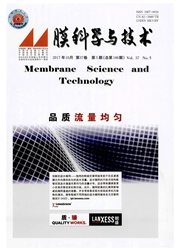

 中文摘要:
中文摘要:
采用低温等离子体接枝技术改性聚偏氟乙烯膜(PVDF),在PVDF膜表面引入疏水性单体苯乙烯,达到改变膜表面孔径的大小和孔径分布的目的.通过傅立叶红外光谱仪(FTIR—ATR)对改性前后的PVDF膜表面进行了结构分析,考察了PVDF膜接枝前后官能团的变化.采用示差扫描量热仪(DSC)分析了PVDF改性前后膜的孔径分布,考察了改性条件对膜孔径大小和分布的影响.通过扫描电子显微镜(SEM)和原子力显微镜(AFM)观测了PVDF膜改性前后表面形貌的变化.研究了接枝温度、接枝时间等接枝条件对PVDF改性膜纯水通量的影响.结果表明,随着照射时间和接枝时间的延长,PVDF改性膜的孔径分布变窄,纯水通量下降,接枝率提高.
 英文摘要:
英文摘要:
In order to control surface pore sizes of polyvinylidene fluoride (PVDF) membranes and their distribution, low temperature plasma- induced grafting modifications of PVDF were studied to prepare hydrophobe membranes. By argon (At) treating and subsequent grafting reaction, a hydrophobe monomer, styrene, was introduced onto PVDF membrane. The structure and chemical composition at the PVDF surface were characterized by reflection FTIR. The surface modifications of PVDF were investigated by scanning electron microscope (SEM), atomic force microscopy (AFM) and differential scanning calorimeter (DSC). The effectiveness of modification and the chemical changes at the modified surface was studied under different plasma operating variables and graft reaction conditions such as plasma time and graft time. It was revealed that styrene monomers were successfully grafted onto PVDF membranes. The water permeability was measured by PVDF membrane modified in different graft condition. With the increasing of plasma time and graft time, the pores in the modified membranes became smaller and the distribution of pores narrowed, and the pure water flux decreased.
 同期刊论文项目
同期刊论文项目
 同项目期刊论文
同项目期刊论文
 期刊信息
期刊信息
